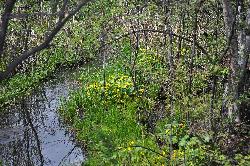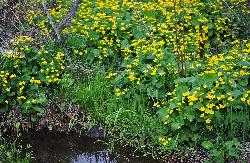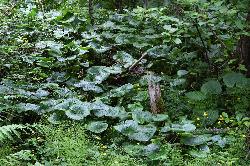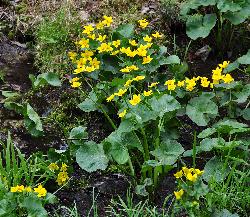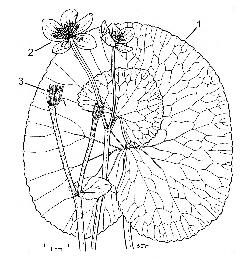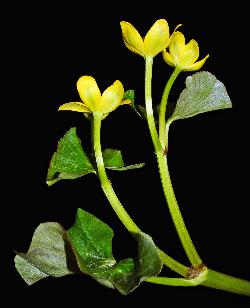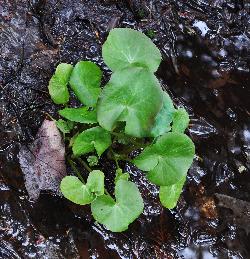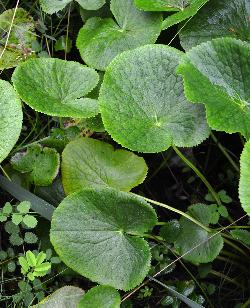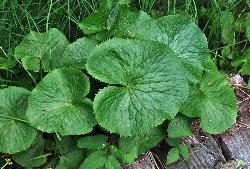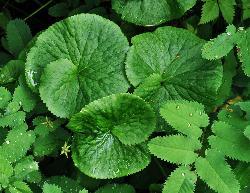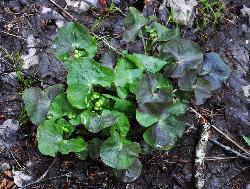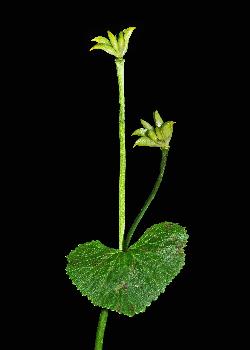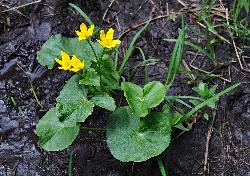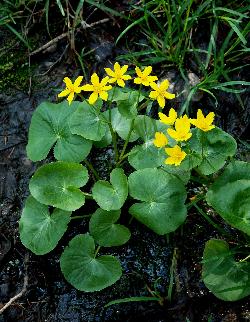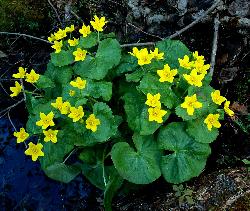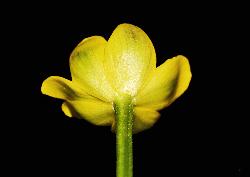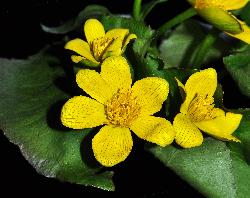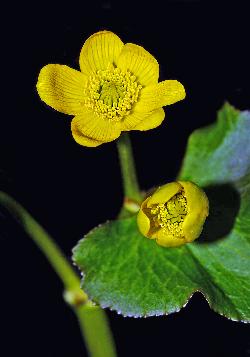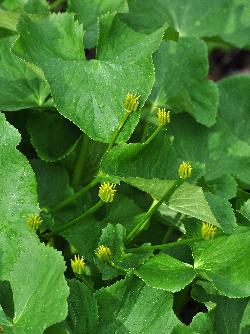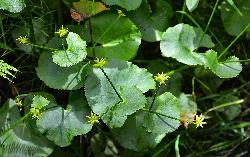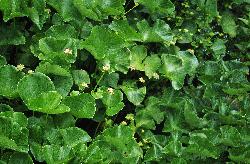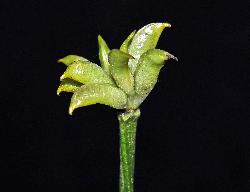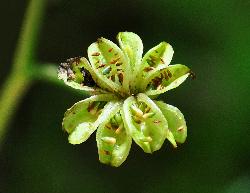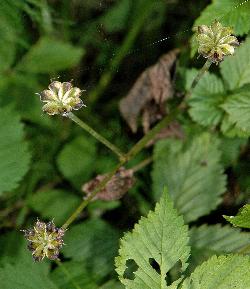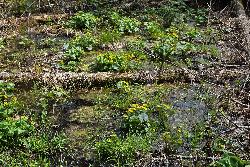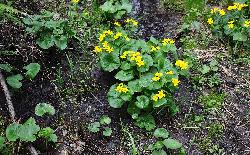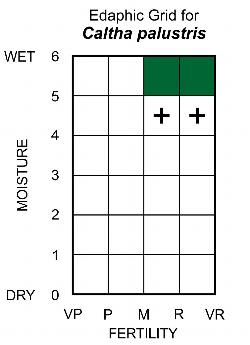Fr: populage des marais, souci d'eau
Ranunculaceae - Buttercup Family
Note: Numbers given in square brackets in the text refer to the images presented above; image numbers are displayed to the lower left of each image.
General: A perennial glabrous forb, 1.5–8 dm tall, with early spring-blooming bright yellow flowers; commonly found in swamps and around the margins of slow-moving streams [1–4]. Warning: All uncooked parts of marsh marigold plants are poisonous to humans and other mammals, with toxicity increasing with plant maturity; very young leaves and flower buds are reportedly edible (Couplan 1998). The active ingredient is protoanemonin, a bitter, irritating, yellow oil that may cause skin irritation, depression, nausea, vomiting, weakness, and eventually death, depending on the amount ingested (Penn Veterinary Medicine 2016, Trull 2016).
Key Features: (numbers 1–3 refer to the illustration [5])
- Basal leaves are large, cordate to reniform; the base is deeply cordate, often with overlapping lobes; margins are dentate to nearly entire.
- Flowers deep yellow, with 5–9 petaloid sepals, numerous stamens, and 4–12 pistils.
- Fruit a cluster of several beaked follicles terminating the flowering stalk.
Stems: Flowering stems are stout, hollow, weak, and erect to decumbent [6]; after the fruits dehisce, erect flowering stems become decumbent.
Leaves: Basal and cauline, petiolate, glossy when young. Basal leaves have long petioles and large ovate, cordate, or reniform blades, 2– 12 cm long by 2–19 cm wide. Apices are rounded, bases are cordate, with open sinuses between or lobes, or with broadly overlapping lobes [7–10]. Margins are usually dentate, sometimes nearly entire in young leaves [11]. Cauline leaves are alternate and occur only on flowering stems; petioles are short or lacking on upper cauline leaves, and blades are typically smaller than those of the basal leaves [6, 12]. Apices of cauline leaves are blunt to rounded; bases are shallowly lobed, rounded, and divergent; and margins are shallowly dentate.
Flowers: Bisexual, with 1–7 flowers in a loose terminal inflorescence (cyme) [13–15]. Flowers are bowl-shaped with radial symmetry (actinomorphic), and measure about 4–5 cm across. The 5–9 sepals are deep yellow, petaloid, elliptic to obovate, 1–2.5 cm long by 0.5–2 cm wide, and often green on the outer surface [6, 16–17]; true petals are lacking. Each flower has numerous stamens (50–100+) and 4–15 distinct pistils [17–18]; each pistil has a flattened oblong superior ovary with a short style and small stigma that develop into a persistent beak at the end of each fruit (follicle). Nectar is secreted by nectaries located at the base of the pistils and collects between them. In Newfoundland and Labrador, marsh marigold blooms in June to early July, soon after the snow melts. Marsh marigold flowers are self incompatible (Lundqvist 1992), thus cross-pollination is essential for seed set. The most common pollinators of marsh marigold are syrphid flies and small bees (mining bees and sweat bees), although many species of insects visit the flowers to consume nectar or pollen (Holm 2014). In one Ontario study, 39 species of insects were documented as visiting the flowers of marsh marigold (Judd 1964).
Fruit: A star-like cluster of 3–15 beaked follicles, 0.8–1.5 cm long, develops at the end of each pedicel; the follicles are initially erect, but spread laterally as the fruits develop, forming star-like clusters [19–21]. The oblong follicles recurve slightly and dehisce along the upper surface, revealing several small elliptic seeds, 1.5–2.5 mm long [22–24]. Immature seeds are green with a pale corky base, but mature to black and are able to float. Dispersal is by rain and water, with rain water washing the seeds from the follicles, followed by farther dispersal of the seeds by water currents (ombrohydrochory) (van der Pijl 1972).
Ecology and Habitat: Marsh marigold is found on wet, nutrient-rich, mucky soils in forested fens and alder swamps, where the water table is at or near the surface for most of the year [25–27].
Edaphic Grid: See image [28], the Edaphic Grid for Caltha palustris.
Forest Types: Marsh marigold is usually encountered in the following western Newfoundland forest types:
- Alnetum caricetosum (Carex-Alder Swamp Subassociation)
- Alnetum equisetetosum (Equisetum-Alder Swamp Subassociation)
- Carici-Piceetum (Carex-Black Spruce Fen Association)
Succession: Marsh marigold is rarely affected by fire, because it grows in habitats where the water table is at or near the surface for most of the year. Harvesting is also rare in the marsh marigold habitat which has a low tree cover. But large individual trees, particularly white spruce, can occur due to the high nutrient and moisture availability. Where harvesting does occur, the compaction of the mucky soils characteristic of these sites can raise the water table and cause marsh marigold to spread along the skidder tracks.
Distribution: Marsh marigold has a disjunct circumboreal distribution and is found in every province of Canada (Scoggan 1978). In Newfoundland, it is native in the west coast portion of the island, extending from Port-aux-Basques north to Quirpon Island and east to Englee; introduced populations also occur in St. John’s and on the southern Burin Peninsula. In Labrador, it occurs only in the Labrador Strait area (ACCDC 2016). In the United States, it occurs mainly in the northeastern and north-central States, but is also known from the west coast, where it occurs in isolated disjunct locations in Washington, Oregon, and northwestern California (USDA, NRCS 2016).
Similar Species: As the earliest blooming spring forb in swamps and along slow watercourses, marsh marigold is seldom confused with other plants. Its deep yellow flowers are similar in appearance to those of buttercups (Ranunculus spp.), but buttercup flowers have 5 green sepals and 5 yellow petals, while marsh marigold flowers have 5–9 petaloid sepals. Buttercup species also have smaller divided leaves than the large, simple, deeply cordate leaves of marsh marigold.


